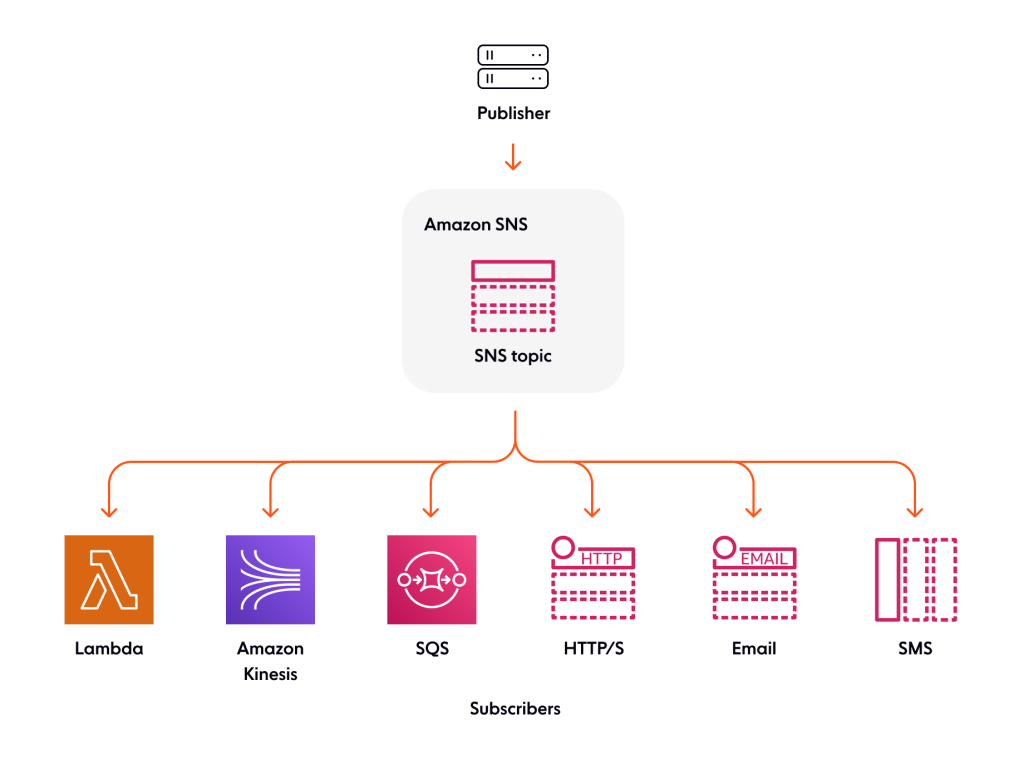Exploring Amazon SNS and SQS Queues

Integration of Amazon SNS and SQS Queue: Efficient Messaging and Queuing Solution
Introduction
In today’s rapidly evolving technological landscape, efficient communication and data processing are essential for the smooth operation of distributed systems. Amazon Simple Notification Service (SNS) and Amazon Simple Queue Service (SQS) are two powerful AWS services designed to facilitate messaging and queuing in modern applications. This blog post will delve into the functionalities, benefits, and integration of Amazon SNS and SQS, providing a comprehensive guide for leveraging these services in your projects.
What is Amazon SNS?
Amazon Simple Notification Service (SNS) is a fully managed messaging service that enables you to decouple and scale microservices, distributed systems, and serverless applications. SNS is designed for high-throughput, push-based, many-to-many messaging.
Key Features of Amazon SNS
- Pub/Sub Messaging: SNS uses the publish-subscribe messaging model, allowing a single message to be delivered to multiple subscribers.
- Multiple Protocols: Messages can be sent via various protocols, including HTTP/S, email, SMS, and AWS Lambda functions.
- Message Filtering: Subscribers can filter messages by attributes, receiving only relevant notifications.
- Scalability: SNS scales automatically to handle high message volumes, making it suitable for large-scale applications.
- Security: Integrated with AWS Identity and Access Management (IAM) for access control and message encryption.
Common Use Cases for Amazon SNS
- System Alerts: Notify administrators of critical system events or errors.
- Content Updates: Inform users about new content or updates.
- Application Integration: Decouple microservices for enhanced system resilience and scalability.
- Mobile Notifications: Send push notifications to mobile devices.
What is Amazon SQS?
Amazon Simple Queue Service (SQS) is a fully managed message queuing service that enables you to decouple and scale microservices, distributed systems, and serverless applications. SQS is designed to handle the queuing of messages, ensuring they are processed reliably and in order.
Key Features of Amazon SQS
- Decoupling Components: SQS allows different components of a system to communicate asynchronously, improving resilience and scalability.
- Message Retention: Messages are retained in the queue until they are processed and deleted.
- Scalability: SQS scales automatically to handle large volumes of messages.
- Visibility Timeout: Controls how long a message is hidden after being read from the queue, preventing multiple consumers from processing the same message.
- Dead-Letter Queues: Unprocessed messages can be moved to a dead-letter queue for further analysis.
Common Use Cases for Amazon SQS:
- Task Scheduling: Schedule and manage background tasks.
- Workflow Management: Coordinate complex workflows across different systems or services.
- Load Leveling: Smooth out load spikes by queuing requests and processing them at a consistent rate.
- Event Logging: Log events for auditing and monitoring purposes.
Integrating Amazon SNS and SQS
Integrating Amazon SNS and SQS combines the strengths of both services, enabling robust and scalable messaging and queuing solutions. Here’s how you can effectively integrate them:
-
Publish Messages to SNS:
- Use SNS to publish messages from various sources, such as web applications, IoT devices, or backend services.
-
Subscribe SQS Queue to SNS Topic:
- Create an SQS queue and subscribe it to the SNS topic. This ensures messages published to the SNS topic are automatically delivered to the SQS queue.
- This integration allows for durable message storage and reliable processing.
-
Process Messages from SQS Queue:
- Implement a service or application that reads messages from the SQS queue and processes them accordingly.
- Ensure messages are deleted from the queue after successful processing to prevent duplication.
Example Integration Workflow
- Event Generation: A user action triggers an event, such as a new order in an e-commerce application.
- Message Publication: The application publishes a message to an SNS topic about the new order.
- Message Delivery: The SNS topic delivers the message to a subscribed SQS queue.
- Queue Processing: A backend service reads the message from the SQS queue and processes the order (e.g., inventory update, order confirmation email).
Use Case Example
Consider a healthcare application that monitors patient vital signs using IoT devices. These devices continuously send data to the application, which uses Amazon SNS to publish alerts for critical events, such as abnormal heart rates or blood pressure levels. The alerts are then delivered to an SQS queue subscribed to the SNS topic. A monitoring service processes these messages from the SQS queue, triggering necessary actions like notifying healthcare providers via SMS or email or logging the event for further analysis. Additionally, using Amazon EventBridge, the application can route these events to various AWS services for extended workflows, such as updating patient records in a database or invoking Lambda functions for real-time analytics.
EventBridge Integration Workflow
Event Generation: IoT devices detect abnormal vital signs and send the data to the application.
Message Publication: The application publishes a message to an SNS topic about the critical event.
Event Routing: Amazon EventBridge captures the SNS message and routes it to multiple targets, such as Lambda functions for real-time processing, or an S3 bucket for data storage.
Message Delivery: The SNS topic also delivers the message to a subscribed SQS queue for durable processing.
Queue Processing: A backend service reads the message from the SQS queue, updates the patient’s electronic health record, and sends notifications to healthcare providers.
Conclusion
Amazon SNS and SQS are powerful tools that enhance messaging and queuing capabilities in modern applications. SNS offers scalable and flexible message delivery, while SQS provides reliable and durable message queuing. By integrating these services, you can build robust communication channels and efficiently manage tasks across your distributed systems, ensuring seamless operations and improved performance.
Understanding and leveraging the strengths of Amazon SNS and SQS can significantly enhance your application’s resilience, scalability, and maintainability, providing a solid foundation for handling complex messaging and queuing requirements in today’s dynamic IT environments.

